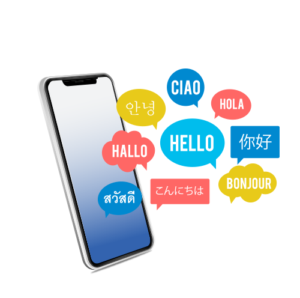A multilingual app enables people to easily communicate with people from different languages. So, creating a multilingual app or creating an app that has this feature is a bonus point for your business. Businesses thrive when they can communicate with their audience properly. And as mobile apps are one of the important channels of communication today, providing them in the local language massively improves the chances of success.
Language can be a barrier for many people who are visiting some other countries or residents of other countries. To encounter this Dubai companies and officials came up with the multilingual app. This made the work of these travelers easy and simple. Because now they don’t have to know Arabic or any language when they come to Dubai or work here. This resulted in more tourism in the U.A.E. Multilingual apps enable people to easily communicate with people from different nationalities speaking different languages as in the case of Dubai.
Localization versus internationalization
Localization of the app is the process of adapting to the specific region or language by translating its assets like images or texts. On the other hand, inter-nationalization is called structuring an app’s code and UI for localization.
A country or region has multiple languages. So, a smart business can launch its app in all the native languages to increase the number of downloads. In fact, case studies and surveys have proved that multilingual apps perform much better than single language apps. People prefer to use the Internet in their own language.
Why multilingual app support is best?
If you want to gain the trust of your users and create your own community having multilingual support is the best. It becomes important when customers are deciding whether to choose your product or not. Some of the advantages of multilingual app support are as below:
- Facilitates entry to new markets
- Increases downloads and hence revenue
- Boosts app store ranking due to increased downloads
- Enables gathering more data on customer behavior, which can be translated into strategic insights
- Drives customer acquisition
- Increases customer loyalty
Now that you know the pros of using a multilingual app now let’s go through some of the aspects of the app that needs to be localized.
- The text read by the user, including menus, button text, etc.
- Images including Alt text and captions
- Audio
- Video with its captions
- Date and time format
- Currency
- Culture-specific information
Below are some tips that we need to keep in mind while creating multilingual app support:
Translation Process
It requires a lot of persistence to translate the app from one language to another. Two methods are widely used for the translation of app.
Human Translation: A multilingual individual is preferred who understands the nuances of the culture. With this, users get more natural content. However, it takes considerable time and resources to find someone competent enough to translate a large amount of work.
Machine translation: Many algorithms have been produced by experts that aim to provide mirror translation in multiple languages. Although languages can be translated at a faster pace, they don’t seem to be authentic in spite of constant efforts to improve them.
But one thing to remember that both translation methods have their own pros and cons.

Avoid concatenation
Avoid concatenation and overuse of single strings. As mentioned above, every language has its own set of principles. The English language will not follow the same order as Russian or French. Using concatenation and single strings for translating will produce many issues related to gender, agreement, and basics. Now that Android and iOS developers can optimize software, concatenation should be avoided at all costs.
Challenges in developing inter-nationalized apps
Some of the challenges while providing multilingual support in mobile apps include:
- The context of the message is very important
- Most of the languages use left to right (LTR) script but there are many languages that use right to left (RTL) script. A truly multilingual app must provide support for both types of scripts.
- Text direction, date, and numbers formats may be different
- A different set of alphabets may be used in the local language
- Not all fonts can be localized
- The design should be flexible enough to accommodate longer text on translation
To increase customer acquisition and engagement businesses are opting for multilingual support. And this is important because 72.4% of consumers are more likely to buy a product that has information in their own language. So, any app that has to be localized must be Inter-nationalized first. Because having multilingual apps facilitates entry to know your markets, increases downloads drive customer acquisition and improve customer loyalty.
Localizing an app involves translating text, image, audio, comic video, etc.; date and time format; currency and culture-specific information to increase downloads, revenue, and app store ranking. Remember, almost all mobile operating systems and app development frameworks provide internationalization and localization support.
Why providing multilingual app is a good business strategy
The more you know about a particular market or region, the better you can approach it. To make a compiling final app, including multilingual app support is a must to achieve success in the long run. With ON AIR App builder create an app that solves this problem of multilingual. Start Now!


